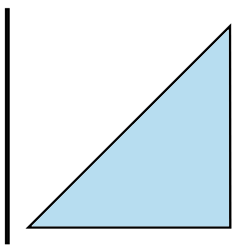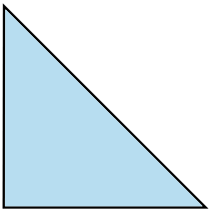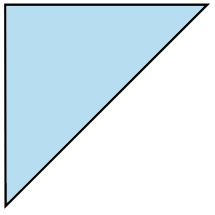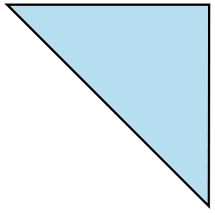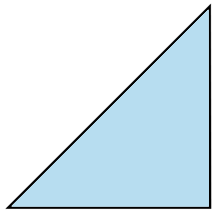Find the value of \(x\), correct to 1 decimal place. (3 marks)
Trigonometry, SMB-062
Trigonometry, SMB-061
Find the value of \(\theta\), correct to the nearest degree. (3 marks)
Trigonometry, SMB-060
Find the value of \(\alpha\), correct to the nearest degree. (2 marks)
Trigonometry, SMB-059
Find the value of \(\theta\), correct to the nearest degree. (2 marks)
Trigonometry, SMB-058
Trigonometry, SMB-057
Find \(\alpha\), to the nearest degree, such that
\(\dfrac{\sin \alpha}{8} = \dfrac{\sin 60^{\circ}}{11} \) (2 marks)
Trigonometry, SMB-056
Find \(\theta\), to the nearest degree, such that
\(\dfrac{12}{\sin \theta} = \dfrac{15}{\sin 26^{\circ}} \) (2 marks)
Trigonometry, SMB-055
Find the value of \(x\), correct to 1 decimal place. (2 marks)
Trigonometry, SMB-054
Find the value of \(x\), correct to 1 decimal place. (2 marks)
Trigonometry, SMB-053
Find the value of \(x\), correct to 1 decimal place. (2 marks)
Trigonometry, SMB-052
Find the value of \(x\), correct to 1 decimal place. (2 marks)
Trigonometry, SMC-051
Solve for \(b\), giving your answer correct to 1 decimal place.
\(\dfrac{b}{\sin 22^{\circ}} = \dfrac{17}{\sin 67^{\circ}}\) (2 marks)
Trigonometry, SMB-050
Solve for \(a\), giving your answer correct to 1 decimal place.
\(\dfrac{6}{\sin 53^{\circ}} = \dfrac{a}{\sin 27^{\circ}}\) (2 marks)
Measurement, STD2 M6 2023 HSC 35
Circles and Hyperbolas, SMB-019
Find the centre and radius of the circle with the equation
`x^2+6x+y^2-y+3=0` (2 marks)
Circles and Parabolas, SMB-018
- Find the centre and radius of the circle with the equation
- `x^2-2x+y^2+3y-3/4=0` (2 marks)
--- 4 WORK AREA LINES (style=lined) ---
- Sketch the circle on the graph below. (1 mark)
--- 0 WORK AREA LINES (style=lined) ---
Circles and Hyperbolas, SMB-017
- Find the centre and radius of the circle with the equation
- `x^2-4x+y^2+6y+9=0` (2 marks)
--- 4 WORK AREA LINES (style=lined) ---
- Sketch the circle on the graph below. (1 mark)
--- 0 WORK AREA LINES (style=lined) ---
Circles and Hyperbolas, SMB-016
Find the centre and radius of the circle with the equation
`x^2+ y^2+8y= 0` (2 marks)
Circles and Hyperbola, SMB-015
Find the centre and radius of the circle with the equation
`x^2+10x + y^2-6y+33 = 0` (2 marks)
Circles and Hyperbolas, SMB-014
- Find the centre and radius of the circle with the equation
- `x^2+6x+y^2+4y+4=0` (2 marks)
--- 4 WORK AREA LINES (style=lined) ---
- Sketch the circle on the graph below. (1 mark)
--- 0 WORK AREA LINES (style=lined) ---
Circles and Hyperbolas, SMB-013
- Write down the equation of the circle with centre `(1, -2)` and radius 2. (1 mark)
--- 2 WORK AREA LINES (style=lined) ---
- On the graph, sketch the circle in part (a). (2 marks)
--- 0 WORK AREA LINES (style=lined) ---
Circles and Hyperbolas, SMB-012
Write down the equation of the circle with centre `(0, -3)` and radius 4. (1 mark)
Circles and Hyperbolas, SMB-011
Find the centre and radius of the circle with the equation
`x^2-12x + y^2 + 2y-12 = 0` (2 marks)
Circles and Hyperbolas, SMB-010 MC
A circle with centre `(a,-2)` and radius 5 units has equation
`x^2-6x + y^2 + 4y = b` where `a` and `b` are real constants.
The values of `a` and `b` are respectively
- −3 and 38
- 3 and 12
- −3 and −8
- 3 and 18
Quadratics, SMB-015
The diagram shows the curve with equation `y = x^2-7x + 10`. The curve intersects the `x`-axis at points `A and B`. The point `C` on the curve has the same `y`-coordinate as the `y`-intercept of the curve.
- Find the `x`-coordinates of points `A and B.` (2 marks)
--- 4 WORK AREA LINES (style=lined) ---
- Write down the coordinates of `C.` (2 marks)
--- 4 WORK AREA LINES (style=lined) ---
Quadratics, SMB-014
Circles and Hyperbolas, SMB-009
Sketch the graph of `y=4/(x-3)`. (3 marks)
--- 0 WORK AREA LINES (style=lined) ---
Circles and Hyperbolas, SMB-008
Sketch the graph of `y=2/(3-x)`. (3 marks)
--- 0 WORK AREA LINES (style=lined) ---
Circles and Hyperbolas, SMB-007
Sketch the graph of `y=3/(x+1)`. (2 marks)
--- 0 WORK AREA LINES (style=lined) ---
Circles and Hyperbolas, SMB-006
Sketch the graph of `y=1/(x-2)`. (2 marks)
--- 0 WORK AREA LINES (style=lined) ---
Circles and Hyperbolas, SMB-004
- List all asymptotes of the graph `y=2-1/x`. (2 marks)
--- 3 WORK AREA LINES (style=lined) ---
- Hence, sketch the graph of `y=2-1/x`. (2 marks)
--- 0 WORK AREA LINES (style=lined) ---
Circles and Hyperbolas, SMB-003
Sketch the graph of `y=2/x+2`.
Clearly mark all asymptotes. (3 marks)
--- 0 WORK AREA LINES (style=lined) ---
Circles and Hyperbola, SMB-002
Sketch the graph of `y=-2/x`. (2 marks)
--- 0 WORK AREA LINES (style=lined) ---
Circles and Hyperbola, SMB-001
Quadratics, SMB-013
Factorise the parabola described by the equation `y=-x^2-x+12` and find its vertex. (3 marks)
--- 6 WORK AREA LINES (style=lined) ---
Quadratics, SMB-012
- Factorise `y=x^2-8x+15` (1 mark)
--- 2 WORK AREA LINES (style=lined) ---
- Find the vertex of the parabola with equation `y=x^2-8x+15` (2 marks)
--- 4 WORK AREA LINES (style=lined) ---
Quadratics, SMB-011
- Factorise `y=2x^2+5x-3` (1 mark)
--- 2 WORK AREA LINES (style=lined) ---
- Find the vertex of the parabola with equation `y=2x^2+5x-3` (2 marks)
--- 4 WORK AREA LINES (style=lined) ---
Quadratics, SMB-010
- Factorise `y=6-x-x^2` (2 marks)
--- 4 WORK AREA LINES (style=lined) ---
- Find the vertex of the parabola with equation `y=6-x-x^2` (2 marks)
--- 5 WORK AREA LINES (style=lined) ---
Quadratics, SMB-009
By completing the square, find the coordinates of the vertex of the parabola with equation
`y=x^2-3x+1` (3 marks)
Quadratics, SMB-008
By completing the square, find the coordinates of the vertex of the parabola with equation
`y=x^2+8x+9` (3 marks)
Quadratics, SMB-007
By completing the square, find the coordinates of the vertex of the parabola with equation
`y=x^2-6x-4` (3 marks)
Exponential, SMB-006 MC
Exponentials, SMB-004
Exponential, SMB-003
By completing the table of values, sketch the graph of `y=2^(-x)` (3 marks)
\begin{array} {|l|c|c|c|c|c|}
\hline
\rule{0pt}{2.5ex} \ \ x\ \ \rule[-1ex]{0pt}{0pt} & -2 & -1 & \ \ 0\ \ & \ \ 1\ \ & \ \ 2\ \ \\
\hline
\rule{0pt}{2.5ex} \ \ y\ \ \rule[-1ex]{0pt}{0pt} & & & 1 & & \\
\hline
\end{array}
--- 0 WORK AREA LINES (style=lined) ---
Transformations, SMB-024
Points `P` and `Q`, shown on the Cartesian plane diagram, are rotated 180° about the origin and become points `P^(′)` and `Q^(′)`.
Plot the points `P^(′)` and `Q^(′)` on the diagram. (3 marks)
--- 0 WORK AREA LINES (style=lined) ---
Transformations, SMB-023
Point `Q(3,1)` on the Cartesian plane is rotated 180° about the origin in a clockwise direction to become point `Q^(′)`.
What are the coordinates of `Q^(′)`. (2 marks)
--- 8 WORK AREA LINES (style=lined) ---
Transformations, SMB-022
Point `A(4,-3)` on the Cartesian plane is rotated 90° about the origin in a clockwise direction to become point `A^(′)`.
What are the coordinates of `A^(′)`. (1 mark)
--- 8 WORK AREA LINES (style=lined) ---
Transformations, SMB-021
Point `P(-3,-7)` on the Cartesian plane is rotated 90° about the origin in an anticlockwise direction to become point `P^(′)`.
What are the coordinates of `P^(′)`. (1 mark)
--- 8 WORK AREA LINES (style=lined) ---
Transformations, SMB-020
Points `P` and `Q`, shown on the Cartesian plane diagram, are rotated 90° about the origin in a clockwise direction to become points `P^(′)` and `Q^(′)`.
Plot the points `P^(′)` and `Q^(′)` on the diagram. (2 marks)
--- 0 WORK AREA LINES (style=lined) ---
Transformations, SMB-019
Transformations, SMB-018 MC
Transformations, SMB-017
Transformations, SMB-016 MC
Transformations, SMB-015
Gabby put 5 points on a grid and labelled them `A` to `E`, as shown on the diagram below.
Point `A` is 35 millimetres from point `D.`
Gabby adds a sixth point, `F` so that the arrangement of points has one line of symmetry.
How far is point `F` from point `B?` (3 marks)
--- 5 WORK AREA LINES (style=lined) ---
Transformations, SMB-014 MC
Transformations, SMB-013
The trapezium `ABCD` is moved to the new position shown by trapezium `SRQP.`
Which of these transformations resulted in the new position?
- Rotate `ABCD` 180° clockwise about the origin.
- Rotate `ABCD` 270° clockwise about the origin.
- Reflect `ABCD` across the `x`-axis, then translate 8 units left.
- Reflect `ABCD` across the `y`-axis, then translate 7 units down.


